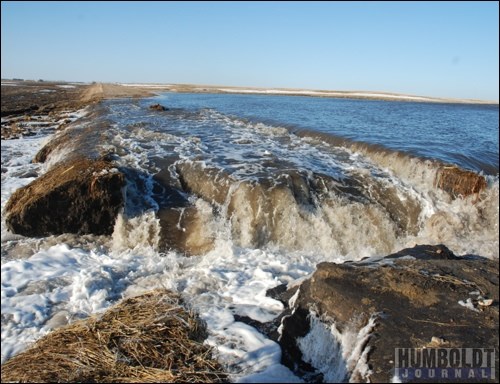We are in for a lot of runoff this spring.
At least, that's what the forecasters are predicting so far.
The Water Security Agency (WSA) (previously the Saskatchewan Watershed Authority) released its February Forecast last week, stating that an above normal runoff is expected this spring.
"The spring runoff is impacted by a variety of factors like moisture conditions in the fall, snow accumulation in the winter, as well as the rate of melt and amount of rainfall," said Ken Cheveldayoff, Minister responsible for WSA in a news release. "The WSA is paying close attention to these factors and will assess the situation as we approach spring."
While there was below normal rainfall in the past half of 2012, leaving most of the agricultural land in the province dry going into winter, to date, "there has been above normal winter precipitation and well above-average water equivalent in the snowpack for this time of year," the report states.
"If the precipitation conditions going forward remain the same as their historical averages, there will be an above average spring runoff this year."
As of February 1, 2013, the report notes, "recorded winter precipitation... across the entire southern half of the province has been above normal. The estimated water equivalent in the snowpack on February 1 is generally 150 per cent to 200 per cent of average for this time of year."
This means there is 150 to 200 per cent more water in that snow when it melts than there usually is.
"Thus, above normal runoff is expected assuming average precipitation between now and spring runoff," the report notes. "If the above normal winter precipitation trend continues, 2013 runoff will likely be well above average."
There were extremely high runoffs north of Humboldt in 2011 - so much so that extreme measures were taken to divert the water into the Waldsea Lake basin rather than see it flood surrounding farm lands. A berm was broken on Dead Moose Lake, which allowed water to flow back into Waldsea and raise it by 17 feet when spring came.
Cabins and dwellings in the area had been moved out over the winter months when the plan was approved, but at least one farm was still endangered by the water around it.
Then spring runoff in 2012 was near normal, the WSA states, refilling most water supply reservoirs. A lot of rain in April and May across most of the province kept those reservoirs full, then summer came and the rains stopped, for the most part, falling below normal.
Around Humboldt, topsoil moisture conditions in the fall were short. But snowfall between November and February has put this area in a zone with the potential for well above normal runoff. There are two such zones in the province. The one including Humboldt also includes Melfort, Prince Albert, Saskatoon and areas just south of North Battleford. The other zone is in the southeast, including Wynyard, Yorkton, Indian Head, Regina, Moose Jaw and Last Mountain.
The WSA advises that their February forecast should be used as a general guide, as local conditions vary, and in-depth information on specific regions is not yet available.
A more in-depth report will be released in March.
However, rainfall during runoff can be another factor that will have a major impact on runoff, the WSA added.
The WSA gathered their data using satellite imagery and on-ground testing, explained Patrick Boyle of the WSA.
They took snow samples from across the province and compared them to satellite information and accumulated snow data from across the province to come up with their first forecast of the year.
However, he added, it's really too early to tell a lot right now.
This report "gives us an idea," Boyle said. "We're trying to get a clear picture... we might not get that until March."
The March forecast will be more detailed for individual areas, Boyle said, and give more information into what conditions look like just prior to spring.
A whole lot of things can happen from now until then, he indicated.




